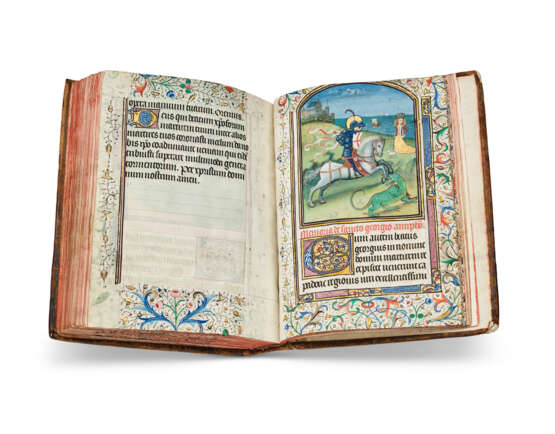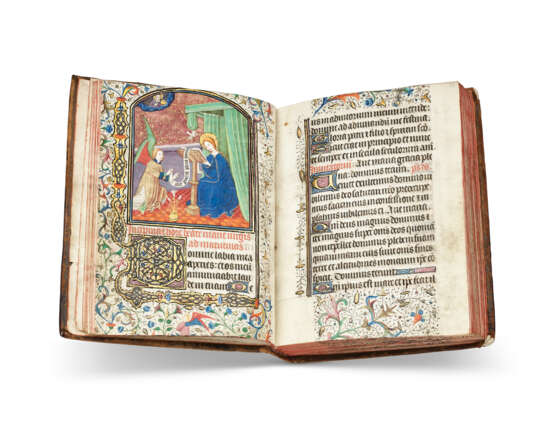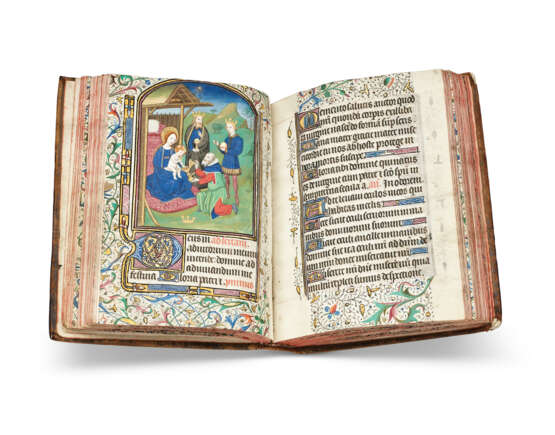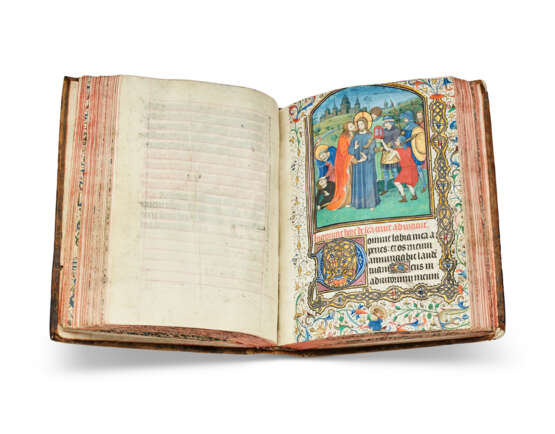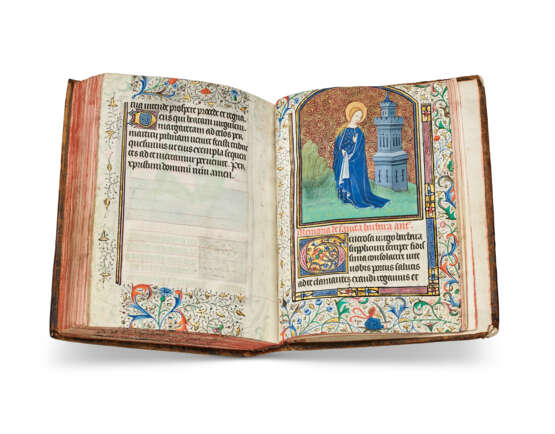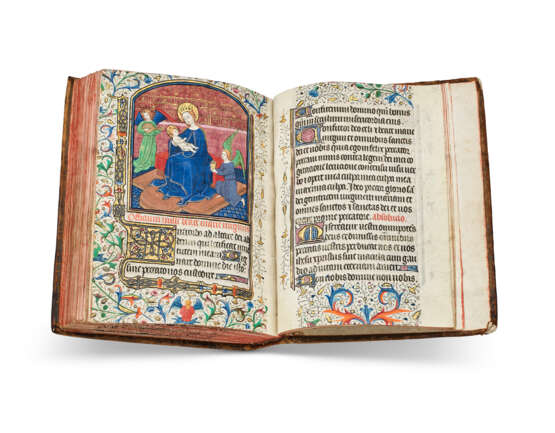ID 1349679
Lot 10 | Masters of the Gold Scrolls
Valeur estimée
£ 40 000 – 60 000
Book of Hours, use of Rome, in Latin, illuminated manuscript on vellum [Bruges, c.1440s]
A particularly exquisite and ambitious example of the work of the Masters of the Gold Scrolls, drawing on the advances in contemporary painting of Rogier van der Weyden.
167 x 126mm. i +136 + i leaves, complete, collation: i + 16, 24, 32, 4-98, 1011 (of 12, xii a cancelled blank), 11-158, 166, 179,(of 10, x a cancelled blank), 186, 194. 18 lines, ruled space: 122 x 78mm, modern foliation followed here, rubrics in red, illuminated initials and line-fillers in burnished gold on red and blue backgrounds throughout, most pages with three-sided borders, 22 large miniatures within full borders (cropped into margins, the miniatures in excellent condition). Bound in late 17th-century mottled calf, spine gilt (a little scuffed, boards a little warped).
Provenance:
(1) The style of illumination and the Calendar, with Amand and Donatian in red, indicates a Flemish origin. The feasts of Sebastian, Anthony and Hubert have been added in a later hand.
(2) Theodor Oswald Weigel (1812-1881), bookseller and art historian of Leipzig, best known as a collector and publisher of 15th- and 16th-century prints. The present manuscript was no 31 in his posthumous 1898 auction catalogue (Katalog einer Sammlung illuminirter Manuscripte und Miniaturen auf Einzelblaettern aus dem Besitze von T. O. Weigel in Leipzig / Catalogue d’une collection de manuscrits enluminés et de miniatures sur feuilles séparées, provenant de la succession de feu Mr. T. O. Weigel à Leipzig [...] 12 July 1898 et les jours suivants, Leipzig, Oswald Wiegel, 1898, p.35, but the sale was cancelled and all lots within it were acquired instead by:
(3) Karl W. Hiersemann (1854-1928), Leipzig book dealer. An accompanying letter dated Cologne, 13 June 1902, from Carl Aldenhoven (1842-1907), director of the Wallraf-Richartz Museum in Cologne, describes the manuscript as a c.1500 Cologne production. A pencil inscription on the lower board reads ‘ER [=Erwin Rosenthal]’, who likely foliated and collated the manuscript. A faded inscription on the first flyleaf reads ‘No 78 G / 136 blatt / 22 miniaturen / L.O.’ – this could be the Italian publisher and dealer Leo S. Olschki (1861-1940), whose daughter Margherita Erwin married in 1908.
(4) Otto Smith (1864-1935), industrialist, bibliophile and coin collector.
Contents: Calendar ff.1-6v; Gospel sequences ff.7-10; Hours of the Virgin, use of Rome, ff.10v-56: matins f.10v, lauds f.24, prime f.32v, terce f.36, sext f.39v, none f.42v, vespers f.46, compline f.52; Hours of the Virgin for Advent ff.56v-61v; blank f.62; Hours of the Cross ff.63-67v; Hours of the Holy Spirit ff.68-71v; Seven Penitential Psalms and Litany ff.72-86v; Office of the Dead, use of Rome, ff.87-118v; Suffrages ff.119-126v; O intemerata and Obsecro te ff.127-131; Mass of the Virgin ff.131v-135v; blank f.136.
Illumination:
The illumination of the present Hours is a particularly accomplished and refined example of the work of the so-called Masters of the Gold Scrolls, known for the fine, undulating liquid gold scrollwork used to pattern monochromatic pink-red backgrounds (found here for example on ff.10v and 126) in their earliest phase of manuscript production. The leading providers of book illumination in Bruges from around 1410 to the 1450s, they served a varied clientele and decorated books for the home market and for export. Although generally retrospective in character, drawing on Parisian miniature and border conventions, the later Gold Scrolls artists were aware of the naturalistic advances in contemporary Netherlandish painting and incorporated some of those conventions into increasingly developed landscapes (see G. Clark, 'Mass Production: The Masters of the Gold Scrolls', Splendours of the Burgundian Netherlands, 2018, pp.96-109). The most striking image in the present manuscript is the miniature of George and the Dragon on f.121, set on a high promontory in the foreground with a large body of water below in the distance.
While the George type is a commonplace in Gold Scrolls illumination (see for example the version in the Assen Hours [Assen, Drents Museum, Inv.no.H 1855-8] and no 20 in Splendours of the Burgundian Netherlands, p.102), the more ambitious landscape in our artist's rendition suggests that the responsible Gold Scrolls painter was familiar with Rogier van der Weyden's design for the tiny panel of the subject in the National Gallery in Washington, D.C. (1966.1.1), usually dated in the early 1430s. A further indication of a later date in Gold Scrolls production would be if the borders were framed in red ink or burnished gold, a trend that began in France and the southern Netherlands in the 1440s and rapidly caught on in the 1450s (see G. Clark, Art in a Time of War, 2016, p.168), but the extent of the cropping in our manuscript makes this determination impossible.
The subjects of the large miniatures are as follows: Annunciation f.10v; Visitation f.24; Nativity f.32v; Annunciation to the Shepherds f.36, Adoration of the Magi f.39v; Presentation in the Temple f.42v; Massacre of the Innocents f.46; Flight into Egypt f.52; Coronation of the Virgin f.56v; Betrayal of Christ f.63; Pentecost f.68; Last Judgment f.72; Funeral Mass f.87, John the Baptist f.119, St Christopher f.120, St George f.121; St Sebastian f.122; St Catherine f.123; Mary Magdalene f.124; St Margaret f.125; St Barbara f.126; Virgin and Child with kneeling and music-playing angel f.131v.
Christie's would like to thank Gregory Clark for his help in the preparation of this catalogue note.
| Lieu d'origine: | Belgique, Europe de l'Ouest, Europe |
|---|---|
| Catégorie maison de vente aux enchères: | Manuscrits médiévaux et de la Renaissance, Livres et manuscrits |
| Lieu d'origine: | Belgique, Europe de l'Ouest, Europe |
|---|---|
| Catégorie maison de vente aux enchères: | Manuscrits médiévaux et de la Renaissance, Livres et manuscrits |
| Adresse de l'enchère |
CHRISTIE'S 8 King Street, St. James's SW1Y 6QT London Royaume-Uni | |
|---|---|---|
| Aperçu |
| |
| Téléphone | +44 (0)20 7839 9060 | |
| Commission | see on Website | |
| Conditions d'utilisation | Conditions d'utilisation |
